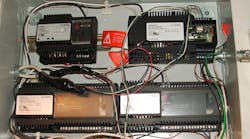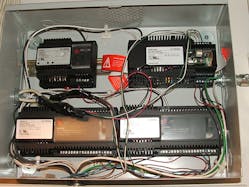How well do you know the Code? Think you can spot violations the original installer either ignored or couldn't identify? Here's your chance to moonlight as an electrical inspector and second-guess someone else's work from the safety of your living room or office. It's your turn to identify the violation.
Hint: Too close for comfort
Find the Answer
The black and white THWN 120V power wiring for this piece of equipment enters this space from the nipple on the bottom of the cabinet. As you can see, several of the low-voltage, Class 2 or 3 circuit conductors are wrapped around these power wires.
Sec. 725.136(A) generally prohibits these power circuit conductors from being installed in any cable, compartment, enclosure, raceway, box, or similar fitting with Class 2 or Class 3 circuit conductors. However, in accordance with Sec. 725.136(D), these power circuits are permitted to be in the same enclosure where they are connected to equipment that is also connected to the Class 2 or 3 circuits. But you must carefully route these circuits so as to maintain a minimum separation of 0.25 inches between the power circuits and the Class 2 and 3 circuits. The rules of separation were clearly ignored for this installation.
Any insulation failure due to a fault could result in dangerous energy levels being imposed on the Class 2 or 3 circuits. It’s also important to note that other separation techniques are permitted such as barriers [Sec. 725.136(B) and (G)] and raceways within enclosures [Sec. 725.136(C)].





